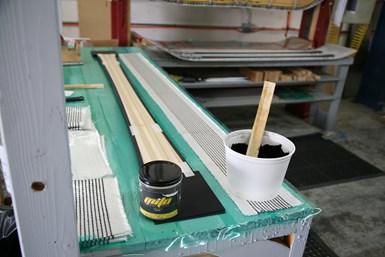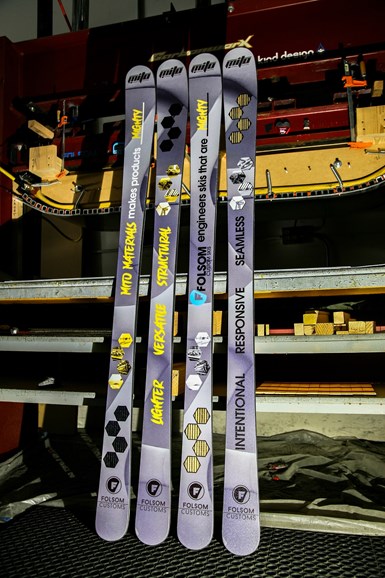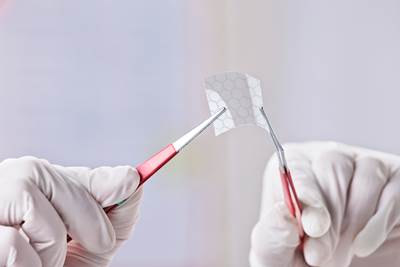
Enhancing high-performance skis. Folsom Custom Skis specializes in customized, hand-built skis for its customers. After a careful prototyping and testing process, the company worked with hybrid materials supplier Mito Material Solutions to redesign its carbon fiber composite touring skis with graphene enhancement to create a lighter weight, higher performance backcountry touring option. Photo Credit: Folsom Custom Skis
In the materials world, graphene has attracted a lot of attention in the last few years. A one atom-thick layer of carbon atoms that is today available commercially in a number of formats that can be integrated into a composite or other material, graphene, even at very low loadings, has been demonstrated to enhance a part’s mechanical properties such as thermal and electrical conductivity, strength, fracture toughness and vibration damping.
Interest in the use of graphene additives is growing in many composite applications and end markets, but barriers to widespread adoption continue to exist, such as standardization and verification of graphene materials available (though this is being worked on by entities such as the Graphene Council and its members), as well as the design and processing challenges that come with incorporating a new additive into any existing product and process.
Folsom Custom Skis (Denver, Colo., U.S.) is one company that has recently adopted a graphene additive product for its newest line of ultralight carbon fiber composite touring skis, having progressed through initial prototyping and testing to redesign of its skis to optimize the property enhancements of graphene.
Designing and building custom high-performance skis
Alongside a small stock retail offering, Folsom’s main business is to design, engineer and build custom skis, each designed to fit the customer’s needs, style and physical characteristics. The ski shape, tail shape, camber (thickness at the ski’s center) and rocker (thickness at the ski’s tip and tail) profile, flex and mix of materials are designed and built by Folsom’s team from tooling to finish. “We’re one of the few in the country that actually do everything here. We machine all of our parts, we do all of the tooling, everything,” says Mike McCabe, owner and CEO.
Putting skis to the test. Folsom employs a team of trusted test skiers, including CEO Mike McCabe, to A/B test any new ski constructions. Photo Credit: Folsom Custom Skis
Generally, each pair of skis is made from one of three composite material combinations to meet weight thresholds: a 90/10 fiberglass/carbon fiber blend, a 70/30 fiberglass/carbon fiber blend (slightly lighter weight) and a 100% carbon fiber laminate (lightest weight). The composite laminate sandwiches a structural core made from one of several wood blends designed to produce the desired stiffness, damping and overall performance of the ski. Other materials in the mix include ultrahigh molecular weight polyethelyne (UHMWPE) sidewalls, vulcanized rubber, steel outer edges and a nylon blend topsheet with a decorative graphic.
In a ski, the fiberglass or carbon fiber acts as a “support mechanism” encapsulating the wood core, McCabe explains. “It’s structural, adds strength and it’s about bonding everything together.”
In Folsom’s process, tooling is first CNC machined in-house. Dry fiberglass or carbon fiber fabrics are cut and, on the layup table, a technician pre-saturates them with a 2K liquid epoxy from Forrest Technical Coatings (Eugene, Ore., U.S.). These are laid up in the mold and layered with the wood core, sidewalls, rubber and topsheet material, with epoxy applied between each of the layers. The whole layup is compression molded under a specific heat and pressure.
“Working with these different materials, all of which have different thermodynamic properties and react differently to temperature and humidity, is certainly the most difficult thing about ski manufacturing,” says McCabe. “You only get one shot, and it has to be extremely precise.”
Introducing graphene enhancement
Folsom’s 100% carbon fiber skis have always been lightweight and high performance, but McCabe says the company has been reluctant to enter into the market for ultra lightweight skis (generally 1,700 grams or less), unwilling to sacrifice performance, strength and stability for extreme weight savings.
He had heard about graphene for years and was intrigued by its potential to enhance a ski’s mechanical properties while enabling less overall material use, amounting to a lower weight ski that still matches Folsom’s high performance standards.
However, he was hesitant at first to try graphene. Folsom had trouble finding a supplier who could provide materials in small enough quantities for what a small company like Folsom would need — plus, McCabe admits he was a bit skeptical at first. “I had an interest in graphene, but I just couldn’t imagine that it would make that big of a change,” he says. “We’re very careful about the materials we put in our products. We build a high-performance, high-quality product and need to be sure that everything we put into it makes a significant difference in a positive way.”
Then in 2020, Folsom was introduced to Mito Material Solutions (Mito, Indianapolis, Ind., U.S.), a supplier of hybrid materials including the functionalized graphene additive E-GO (epoxidized graphene oxide), which combines graphene with a polyhedral oligomeric silsesquioxane (POSS) polymer.
There are many graphene materials on the market designed for use in a wide range of applications — composites, batteries, plastics, adhesives and more — but the E-GO product line was developed specifically to enhance the fracture toughness and to reduce delamination in epoxy-based composite products.
E-GO, available as a powder additive for liquid resins or as a spray for prepregs, is designed as a hybrid material specifically so that it is “chemically compatible with the epoxy resin system, interacting with the fiber at a platelet morphology level,” explains Haley Keith, CEO of Mito Material Solutions. POSS is a nanosilica with an epoxy functionality. “We chose to bond the graphene and POSS together to aid the dispersion and integration of graphene into the polymer matrix.”
She notes that enhancing chemical bonds, increasing fracture toughness and reducing risks of delamination were the primary goals of E-GO when it was being developed — but because graphene is involved, other benefits like vibration damping and thermal and electrical conductivity also come along with it. E-GO also is the first product to be awarded Verified Functionalized Graphene status by the Graphene Council.
Keith explains that the company realized early on that the best strategy would be to start targeting a specific end market. High-performance sporting goods was identified as a niche that could see advantages from the mechanical property gains and chemical bonding benefits of Mito’s materials. Thus, Mito began connecting with companies all along the composites sporting goods supply chain, from resin manufacturers and compounders to parts manufacturers, including Folsom.
In addition, Mito was able to provide materials in the smaller quantites that Folsom needed. Building on previous interest in graphene materials, McCabe decided to give E-GO a try, aiming to see if it could be the ticket for entering the ultra-lightweight touring ski category.
First prototypes
Adding graphene to the mix. For its original prototypes, Folsom’s technicians measured out 10 grams of E-GO into the epoxy that was added to the 90% fiberglass/10% carbon fiber fabric to be laid up with the rest of the wood core and other materials. Photo Credit: Folsom Custom Skis
In 2021, Folsom built its first graphene-enhanced prototype skis. For these, 10 grams of E-GO in powder form were simply added to the epoxy resin for Folsom’s existing skis in the company’s typical construction for resort skis, which use a 90% fiberglass/10% carbon fiber composite blend. These skis are intended for general use at designated ski resorts and slopes, where the skier is taken to the top of the slope by a ski lift.
McCabe explains that Folsom follows a careful and precise prototyping process, including in-house mechanical and field testing. First, Folsom tests the ski’s resistance and deflection, using an actuated test system run by Arduino (New York, N.Y., U.S.) software. For each ski, the test system pulls force onto the center of the ski to measure how much it deflects under a static amount of weight. A “slap test” is also performed to test vibration damping, where an accelerometer measures how quickly the ski damps or shuts down vibrations when pulled off of a surface.
The real test for any ski, though, is out on the slopes, McCabe says: “You can’t replicate the conditions of being out on a real slope in a test lab.”
McCabe himself tests out new ski designs, along with a crew of trusted test skiers and athletes. Test skiers are asked to document characteristics of the skis’ performance, and to do A/B testing, wearing one graphene-enhanced ski and one regular ski at the same time to compare them.
The initial results? The skis were lighter, tougher, stronger and provided particularly effective damping performance — reducing the “chatter” or vibrations felt by a skier on rough terrain. “It turns out, it was a major change in the way that our skis felt and reacted,” says McCabe. However, the addition of E-GO to the typical resort ski build “yielded perhaps too powerful of a ski for a large percentage of Folsom clientele,” he adds.
In addition, measuring out and incorporating E-GO powder manually for each build added additional steps — and additional variables — into the manufacturing process. McCabe explains that working with powder additives can be challenging, with risks of spilling, inconsistency from hand mixing and time added to the process.
These initial prototypes demonstrated the significant mechanical property enhancements that small amounts of graphene can provide for the right type of ski application where both light weight and high-level performance were needed.
Redesigning for graphene enhancement
Touring skis ended up being a better fit than the resort skis that Folsom had originally tried. Designed for use outside of a ski resort in backcountry terrain, touring skis must be able to withstand and perform well in unpredictable conditions, and light weight is even more important than on resort skis, as they need to be carried up the slope without the aid of a ski lift. Folsom’s previous 100% carbon fiber touring ski was its lightest option, but could still weigh upwards of 1,800 or 2,300 grams (3.9 to 5.07 pounds) per ski depending on the ski shape, as Folsom was unwilling to compromise stability and strength in the skis by making them thinner and lighter. By comparison, other touring skis on the market can weigh as little as 1,200 grams (2.6 pounds) per ski.
The addition of E-GO introduced an opportunity for lightweighting, enhancing the strength and toughness of the ski to the extent that some of the original materials were no longer needed. Therefore, Folsom reengineered the materials makeup for its baseline carbon fiber composite ski to remove any unnecessary plastic and composite material layers. Specifically, the thickness of the typical aspen/bamboo core, needed originally for strength and structure, was reduced significantly. In addition, the heavier bamboo material was removed and the UHMWPE sidewalls were reduced in size.
These material changes resulted in removal of up to 300 grams of weight from the overall ski — “which is bonkers,” emphasizes McCabe. He adds, “There is, of course, a cost to putting an additive into the skis, but we’re reducing material costs on the other materials used.”

Redesigning for lighter weight. The addition of graphene added higher strength and vibration damping properties, which enabled Folsom to remove unnecessary materials from the skis, reducing the weight to be more competitive with other ultra-lightweight touring skis. Photo Credit: Folsom Custom Skis
Following a regimen of mechanical and field testing, the graphene-enhanced skis were introduced in 2022 as the UltraLite construction style, available for any of Folsom’s ski shapes.
Beyond the weight savings, UltraLite skis offer advantages compared to Folsom’s previous touring ski options, such as higher strength for a more powerful performance, improved vibration damping and decreased risk of delamination because E-GO promotes better adhesion between the materials and the enhanced epoxy.
The addition of E-GO “helps us get deeper penetration of the epoxy into the wood and in all areas of the ski, which is significant,” says McCabe. He explains that one of the most common failures in skis is delamination, as skis, particularly touring skis, are subject to harsh conditions and temperatures. The E-GO-enhanced skis experience a stronger bond and have seen less delamination.
Proving out E-GO. For Mito, Folsom’s UltraLite skis serve as an example of how hybrid additives like E-GO can be used to enhance and optimize composite parts. Mito has also worked with companies to redesign and optimize graphene-enhanced golf clubs, fishing rods and more. Photo Credit: Mito Material Solutions
The E-GO product itself also evolved to meet customer needs. In 2022, Folsom introduced Mito to its technical coatings supplier, Forrest Technical Coatings. Beginning in 2023, the company began to incorporate E-GO directly into larger batches of its epoxy, to be sold in kits as epoxy resin Mito E-GO Res-1, and a hardener, Mito Tri-Hdnr-1.
With these products, customers can use the hardener and epoxy as usual, and do not need to add E-GO powder themselves into the matrix.“Ultimately, this [partnership with Forrest] gives us the opportunity to provide our customers a novel product with added production efficiencies,” says Keith. McCabe adds that at Folsom, “We’ve moved over to [these products] entirely. It makes our lives a lot easier, and the workability doesn’t seem any different than the normal resin.”
McCabe concludes: “We ended up being able to enter the ultralight ski market with an extremely lightweight ski that still skis really well and meets Folsom’s standards.” Over the next two years, Folsom plans to migrate the majority of its high-performance skis to the UltraLite construction enhanced with E-GO.
Related Content
Goodman Technologies develops aligned nanoforest technologies for composites integration
GTNANO ANT, validated through multiple Phase I-III SBIR/STTR projects, are compatible with a wide range of composite materials and processes, demonstrating ILSS, toughness and fatigue resistance.
Read MoreJEC World 2023 exhibit preview: Mito Materials Solutions
At the Startup Hub, Mito is availabile to discuss its ready-to-pour graphene resin options, customer applications and solutions for taking graphene from the lab to the real world.
Read MoreGoodman Technologies, partners scale up AI-empowered 3D printing of nanocomposites for spacecraft TPS
NASA project addresses the capability gap in TPS production and installation for space exploration and hypersonic systems, delivering an ARMs system, nanopaste and prepreg tapes, manufacturing verification coupons and more.
Read MoreNanomaterials optimize performance of space-ready carbon fiber composite panels
A recent ESA project led by Adamant Composites aimed to mature nanomaterial-enhanced CFRP for lighter weight, more thermally and electrically conductive materials for manufacturing satellite structures.
Read MoreRead Next
Graphene 101: Forms, properties and applications
Graphene-enhanced composites find new applications across end markets as the supply chain continues to mature.
Read MoreNanomaterials: Products, supply chain mature for next-gen composites
Development spans 3D and thermoplastic nanocomposites, nano-CMCs for hypersonics and nanomaterials safety and toxicity.
Read MoreVIDEO: High-volume processing for fiberglass components
Cannon Ergos, a company specializing in high-ton presses and equipment for composites fabrication and plastics processing, displayed automotive and industrial components at CAMX 2024.
Read More

.jpg;width=70;height=70;mode=crop)
























